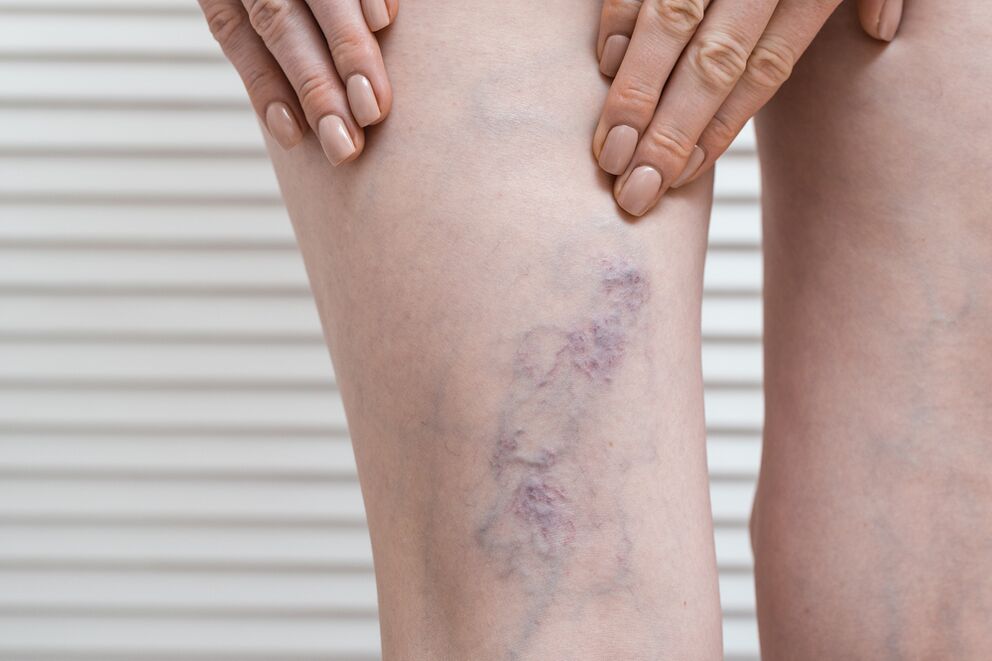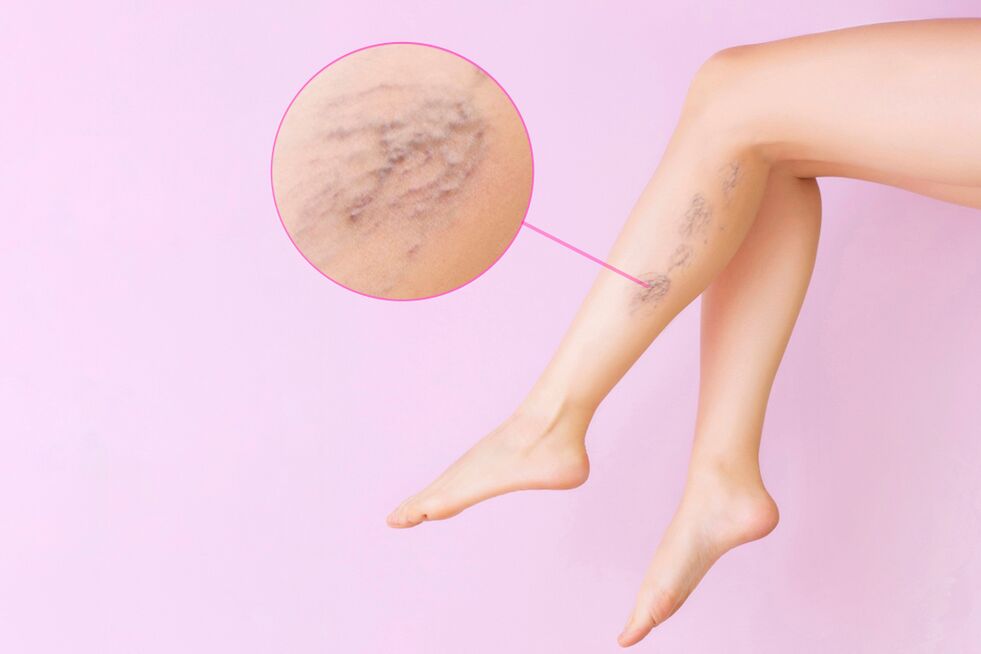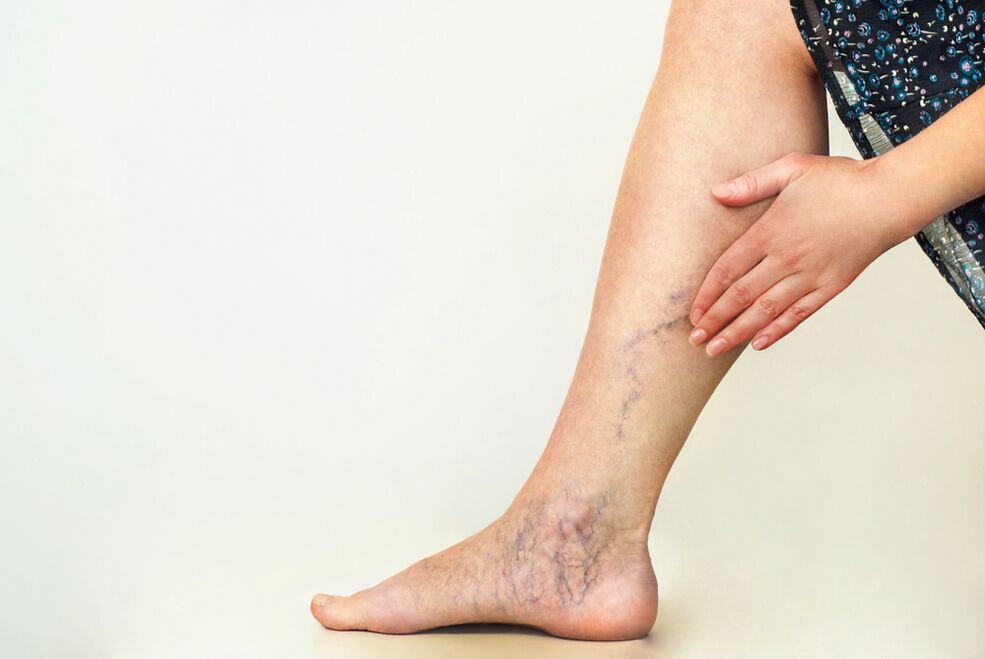Varicose veins of the legs are lesions of the veins under the skin in which they dilate, narrow and become inflamed. Vein valves become inefficient, causing swelling, pain, and circulatory problems. Dangerous complications of varicose veins are thrombophlebitis (inflammation of the vessel wall and formation of blood clots), trophic ulcers, clot separation, embolism of the lungs and other organs, bleeding.

cause of disease
- genetic predisposition;
- Working with feet or sitting for long periods of time, heavy objects, lifting;
- Hormonal changes during pregnancy, private childbirth
- excess weight;
- Advanced age and gender (30% female, 10% male)
Symptoms and mechanisms of development of varicose veins
- swollen legs at night;
- leg pain, heaviness;
- Vascular network, blue skin;
- Increased fatigue from physical exertion;
- venous nodules, soreness, inflammation;
- itchy skin, cramps;
- darkening of the skin;
- Thrombophlebitis, trophic ulcer.
Women's varicose veins mostly occur during childbirth, but timely treatment will pass. It gets worse if women don't go to the doctor and expect to improve after giving birth. However, we must remember that varicose veins do not go away on their own.
The venous bed has two parts: peripheral and deep. Normally, blood should flow from the periphery to the center, i. e. upwards. However, if the tension in the valves and blood vessels is reduced, then blood will start to flow into the superficial veins. As a result, they lengthen, stretch and form knots that can be seen even without instruments. If you don't change your lifestyle and don't start treatment, the disease will get worse because the blood will fall according to the law of gravity. Medication and therapeutic exercise will no longer help at this stage.
diagnosis
In most cases, a doctor and an ultrasound of the leg will suffice. X-ray examination of deep veins and injection of contrast material (venography) may be necessary if there is a risk of recurrence of varicose veins.
How to treat varicose veins in the legs?

In the early stages of the disease, when there are no visible veins and pain, but there is a feeling of heaviness in the legs, it makes sense to see a doctor and start prophylaxis. Internal and topical medications, an active lifestyle, gymnastics, wearing therapeutic compression stockings all fit in here (see list of medications at end).
Preventive measures will pay off, especially if you change jobs and aren't upright for long periods of time. Physician-recommended physical activity will help improve blood flow, as working muscles in the legs significantly strengthen blood vessels. Unfortunately, many people ignore the main symptoms of varicose veins. In the future, expensive methods must be resorted to.
Modern methods of treating varicose veins
There are now effective ways to treat varicose veins without surgery. Their meaning boils down to the following - removal of diseased veins from circulation. With the help of lasers or other methods, the walls of the damaged vein are glued together in the area of the valve, and blood no longer enters this part of the passage. Do one or more punctures, laser access, no anesthesia, no incision, no long-term rehabilitation. As a result, the correct movement of blood is restored and nodules, swelling and pain disappear. The complexion returns to normal and becomes smooth.
Consider treatment without surgery in more detail
Treating patients with lasers has become common over the past decade. If previously damaged veins have to be surgically removed, putting people at risk and prolonging hospital stays, these techniques are obsolete in our day and age. Internal vein coagulation using lasers is widely prescribed. Laser fibers are inserted into the vein through a tiny hole and lead to the damaged valve. Heating with a beam of light causes blood vessel tissue to coagulate, and the walls of veins stick together due to inflammation. This method is also suitable for later stages of varicose veins, when trophic ulcers are present. Efficiency was documented in 98% of patients. According to the same principle, the treatment is carried out with the help of radio wave energy.
If the varicose veins have not reached the dangerous stage, sclerotherapy is used. The technique does not involve the use of heat. A substance is injected into the vein, causing an inflammatory response that subsequently fills the lumen of the vessel. Injectable sclerosing agents have their disadvantages - they have a high rate of recurrence. Sclerotherapy will not eliminate severe blood flow imbalances in large veins. In addition, there may be hypersensitivity to such drugs, and there is a risk of vascular tissue necrosis. Among these advantages, the low cost of the method should be mentioned. Doctors often combine laser therapy with injections.
In addition to laser treatment, phlebotomy - the removal of damaged veins through tiny punctures - is also used. After surgery, patients can go home the same day because there are no incisions. The skin acquires a beautiful appearance, normal color and no scars.

medication for varicose veins
We note again that it is not possible to completely escape pathology only in a conservative manner. Therefore, drug prescriptions are symptomatic and preventive. However, many patients who take the course notice a marked improvement: less pain, swelling and fatigue in the legs.
Venotonics
This group includes drugs based on diosmin: they increase the tone of veins and capillaries, so their ductility and venous congestion decrease. Improve blood circulation, microcirculation, reduce leg swelling, pain, heaviness. Another indication of the drug is the symptomatic treatment of hemorrhoids.
Also produces extrinsic forms of venotonics.
There are many positive things that can be said about IVs containing diosmin, their effectiveness has been proven in clinical trials and side effects are rare. Troxevasin was based on troxerutin before they came into existence. It has a wide range of indications and has anti-inflammatory effects, but it has many side effects. Drops based on horse chestnut seed extract strengthen the walls of veins and improve the condition of capillaries. Also suitable for varicose veins.
topical anticoagulant
This group contains all gels containing sodium heparin. The drug accelerates the absorption of blood clots, reduces tissue swelling, increases capillary circulation, and has anti-inflammatory effects. Varicose veins are its main indication. The line of gel containing heparin is very large and varies in concentration.
Heparin is usually part of the complex external form of varicose veins.
Physiotherapy for varicose veins
Electrophoresis
Under the action of an electric current on a special carrier, the drug is delivered directly to the altered blood vessels (angiotensin, heparin). The procedure is painless, lasts less than an hour, and involves up to 20 sessions. Effectively strengthens the veins, reduces the severity of the disease, but does not completely eliminate the nodules.
Lymphatic drainage, compression therapy
To perform this procedure, you will need equipment: a suit, a compressor. Air is supplied to the suit and distributed to the legs. Tissues and blood vessels are compressed, mimicking what happens with a massage. Improves outflow of lymph fluid, excess water. The duration of exposure is determined by the physician. However, an important contraindication is lymph nodes, herniated veins, renal disease. Compression therapy is only suitable for the initial stages of varicose veins.
magnetic therapy
Use a low-frequency magnetic field to act on the vein. The method can also reduce swelling, pain, and heaviness in the legs. But, of course, broken valves will not be repaired. In general, we can say that all types of physical therapy are good only in the initial stages of varicose veins. We list general contraindications:
- neoplastic disease;
- Pregnant;
- hypertension;
- bleeding;
- tuberculosis;
- epilepsy;
- Coagulation disorders, etc.
In addition to physical therapy, regular cycling can also have positive effects. Exercising the leg muscles will speed up the reverse flow of blood, and over time, the varicose veins will show relief. In general, swimming provides benefits when the venous load is reduced and all muscles are active at the same time. Even after just one session, the swelling is visibly reduced and the legs appear light.
In almost all stages of varicose veins, doctors prescribe compression underwear (stockings, tights, stockings). Elastic tissue supports the vein, increasing its tone and preventing swelling. Such products are often worn after surgery, not just on the legs to protect the veins. For employees who stand for long periods of time, anti-varicose leggings are a must. Proper use of them can prevent the development of diseases.
in conclusion
Early diagnosis of varicose veins helps avoid the development of the disease. Engaging in appropriate exercise and taking intravenous infusion is a good early stage of prevention and treatment. However, in the presence of altered veins, only minimally invasive methods of treatment, or rather laser exposure, are suitable. This technique is costly, but at the same time it is chosen by most patients. Lasers can handle even the most neglected situations. It remains only to ask the most professional phlebologist in the area. After all, therapeutic strategies and method combinations cannot be read on the Internet; unique personal experience counts here.

















